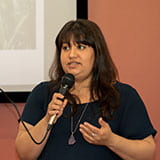SEED projects 2018 – He vaka moana: Navigating Māori and Pasifika student success
Developing Tikanga and Tapu practices in a neuroimaging lab space: Engaging Māori and Pacific in EEG research
 Dr Veema Lodhia (Faculty of Science)
Dr Veema Lodhia (Faculty of Science)
We aimed to develop tikanga protocols that honoured and recognised the tapu of the head and hair. If Māori and Pasifika engagement potentially compromises this tapu, that could impact health outcomes, and the utility of research to inform health and disease policy. We aimed to encourage participation and engagement from Māori and Pacific students in EEG research and neuroscience programs. The new protocol and process would form cultural content for an undergraduate course, Brain and Behaviour, as a taught lecture and examinable content.
Our success depended on support from our Māori and Pasifika collaborators, Psychology Tuākana, and the Kaumatua elders from Te Whānau O Waipareira. Unexpectedly, discussion of methods went beyond the tapu of the head and hair, highlighting the need for researchers to engage in protocols that incorporate whānau and friends’ support. In order to engage, Māori and Pasifika need to connect to the purpose of research and see how it benefits them. Feedback from Tuākana students made the largest impact. The focus groups helped clarify their misconceptions about what was involved in participating in research, resulting in a 1% increase in participation in EEG research. The project made me reflect on my own cultural practices, and how these impact one’s wellbeing; and how ‘western’ models of psychological, medical treatment and wellbeing are assumed to universally apply to all, regardless of cross-cultural, indigenous understandings, knowledge and practices. Furthermore, student narratives made me realise that barriers to research also relate to inequities from class distinctions and hierarchy in research. The protocol we built will provide key training for postgraduate students and researchers on how to incorporate tikanga of the head and hair in EEG. It will also include a karakia (song) and translated documents for participants to take home to whānau. We intend to maintain connections formed and to develop project process into an open-access article/guide, available on the Psychology Māori and Pasifika research webpage. This project fed into our Faculty’s strategic plan for improving retention and success of Māori and Pasifika students. By connecting and engaging with these students early, we hope to see them taking cognitive neuroscience to postgraduate level. The impact of the project has successfully supported the first-year course which involves approximately 1000 students over two semesters. These students are now learning about tikanga practices in a neuro-imaging space, and how incorporating tikanga in our research supports better health outcomes. Students want to learn more, and this is now a regular guest lecture from me.